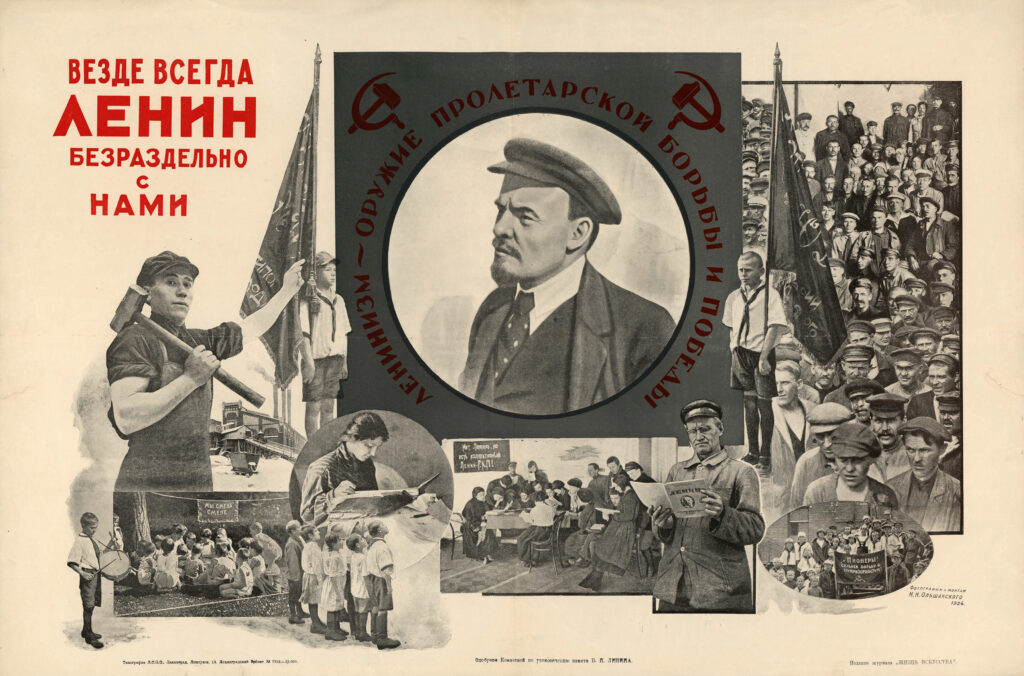Reflections on an Inverted Revolution

We are living through an inverted revolution. The political heirs of Lenin and Gramsci are leading a right-wing transformation from the White House rather than a left-wing one from the streets.1 It is not the campus Marxists, but the thought leaders of the nativist right, who turned out to be the real followers of the great theorists of the Third International. They are implementing the Bolshevik playbook, but with all the value signs reversed. MAGA seeks to smash the state and seize control of civil society; it wants to institute a transitional dictatorship leading to the durable cultural and political hegemony of the far right with the ultimate purpose of overthrowing the existing constitutional order and consolidating itself as a new regime. As a result, the forces of opposition are thrust into the uncomfortable position of defense.
This configuration differs sharply from Trump’s first term. Between 2017 and 2021 Trump’s administration was a shambolic Bonapartist affair. The extreme personalism of his charisma combined with a patrimonial style of rule in which Trump treated his entourage as a group of informal table companions with ill-defined spheres of competence attached to him through quasi familial loyalty. For a brief period at the beginning of his term, some true revolutionaries were around the White House, above all Steve Bannon who proclaimed in 2013, “I am a Leninist. Lenin wanted to destroy the state and that’s my goal too. I want to bring everything crashing down: destroy all of today’s establishment.”2 But these figures were quickly sidelined.
Trump II is a departure in two senses. First, the relative quotient of charisma to patrimonialism is much higher. The president has achieved a quasi-religious status among his inner circle, which fires his immediate entourage with an anti-bureaucratic revolutionary zeal that far outstrips Trump I. Disdaining procedure, routine, and predictability, the group follows commands from the leader because of its belief in his extraordinary personal qualities—not because of their formal correctness or legality, nor because they are part of the Trump “family” in however an extended and fictive sense.
The second feature that sets Trump II apart is the emergence of an actual cadre organization: The Department of Government Efficiency (DOGE) and the group around Russel Vought and Project 2025. DOGE is staffed by men who act in an informal anti-bureaucratic mode. They are bound by a mission—“efficiency”—to which they subordinate all procedural considerations. The organization is omnicompetent with fluctuating and unclear lines of responsibility. This infuses Trump II with a dynamism that his previous administration lacked, and which leads to a pattern of internal conflict different from the first. Whereas Trump I was marked by a clash between patrimonialism and legal-rational authority, the second is characterized by the conflict between cadre organizations and legal-rational authority. In sum, Trump II must be understood sociologically as a conflict between a revolutionary movement that has seized the state and a still-strong Old Regime that is under severe attack.
What is the content of MAGA’s Leninist assault? This is best seen by laying side by side some of the main claims of The State and Revolution and those of Project 2025. Lenin’s key political observation is that every state institutionally embodies the dictatorship of a single class. All states are thus class states not so much because of the class origins of the particular people who govern in them, but because of the class nature of the administrative apparatuses that support those governments. Consequently, to effectuate a transition from any class society to another class society, or even more from a class society to a classless society, requires the violent seizure and smashing of the state.3
In the case of a socialist revolution, the transition unfolds over two main phases. First, the revolutionary forces seize and establish a temporary democratic dictatorship followed by a gradual withering away of the state after the class enemy has been eliminated. To this, Gramsci, whose basic allegiance to Leninism is beyond doubt, added the idea that rule was exercised not only in the state but in civil society and that a consistently revolutionary policy must seek to either completely transform the existing associational sphere or to create a new one.4
In MAGA ideology the analogue to the notion of the class state is the “administrative state” described by the arch-conservative Kevin D, Roberts as the “secret lifeblood of the great awokening.”5 This set of structures, the career bureaucracy, must be dismantled because it entrenches the interests of the “Left” in a structural sense; this is strictly analogous to how Lenin thought the bureaucracy entrenched the interests of the bourgeoisie. For MAGA the bureaucracy cannot be transformed by replacing the current staff with reliable people. For its dedication to “wokeism” is structural, not personal. It must be smashed. To undertake this smashing requires in the first instance a massive concentration of executive power, echoing the notion of the democratic dictatorship. But, MAGA assures us, all of this is in the ultimate service of returning “self-governance to the American people,”6 a project that recalls Lenin’s second phase of the “withering away of the state.” The project also borrows from the Gramscian corpus insisting on the importance of making the “institutions of American civil society hard targets for woke culture warriors.”7 Thus, at every point the current regime follows the Leninist/Gramscian model in a technical sense.
MAGA’s Leninism, however, is peculiarly nihilistic in lacking any future-oriented vision. One might object that the MAGA project is American greatness and that implies some kind of future vision. And in what does that consist? A list would include: the re-emergence of labor-intensive low-skilled manufacturing together with a re-edition of 19th century–style imperialism and a consumer market flooded with shoddy and unsafe products after the dismantling of the regulatory agencies—thus burgeoning inequality, an immiserated population, war and disease; women attacked, reviled and stripped of their rights, together with all those who question heteronormative dominance; the panoply of Civil Rights legislation inverted and weaponized, turned into a terror instrument against anyone who espouses “incorrect ideology” or “poisonous ideas”; a perverse crusade against protestors of Israel’s genocidal war in Gaza under the comically bad-faith moniker of the struggle against “antisemitism”; a police state aimed in the first place against anyone from outside the country but threatening all, aided by AI and social media.
What sort of ideological appeal can MAGA make: personal enrichment, smashing, plunder? Is the idea that the “base” will participate vicariously in the orgy of self-dealing? Perhaps it offers the pleasure of vengeance or simply the joy of witnessing cruelty raining down on the weak and defenseless. But this is not a worldview: Nihilism, not ideology, is the glue. This is most evident from the rationalizations for the new tariff regime. In a vague echo of the various justifications of revolutionary violence offered by the Leninist tradition, we are told that they are the price that must be paid to reach the El Dorado of American Greatness. But no one can figure out even in theory how this is supposed to work. In understanding these policies, knowledge is a positive handicap for it leads the analyst to impute a rationality where none exists. The phenomenon of “sane-washing” is the latest iteration of Hegel’s Owl of Minerva: the attempt to impute a rationality to historical actions that escape the explicit intentions of their authors. It is subject to all the same mystifications as the original. The golden age of American greatness thus reveals itself as a cheap imitation of the awful presidency of William McKinley with “post-modern” characteristics. Not even the National Socialists proposed a future so devoid of prospects. At least they had the People’s Community: a mystified simulacrum of their socialist enemy.
MAGA, then, in the sharpest possible contrast to authentic Leninism, lacks a compelling vision of the future: It is a purely technical or tactical revolutionary movement. In contrast, the Bolsheviks, whatever their many and serious mistakes, were, in their self-conception, dedicated to the liberation of humanity.
The enthronement of nihilistic Leninism in power places its opponents in an odd position. They have become willy-nilly defenders of the status quo. But as a general matter this tribe is much better equipped with the tools of unmasking and critique than with those designed to defend what is worth defending. In a sense their situation strangely mirrors the MAGA project. For they are conservatives who lack a conservative ideology facing a group of revolutionaries equally lacking a revolutionary ideology. How to navigate conceptually and politically this peculiar terrain?
Since we are living through a revolution, a reconsideration of the meaning of the term is of some use. Before the French Revolution it referred to a cyclical process: in the natural world, the revolution of the planets around the sun, and in the political world, the cycling through of forms of government. 1789 was a break. Only with the French Revolution does the idea acquire the meaning of an act of foundation set off by a mass uprising, and only in the 20th century, basically with Lenin, does anything like a theory of revolution emerge.
Further, it is only from the French Revolution that counter-revolution, the bedrock of what later will be called conservatism, appears, often dated to Burke’s Reflections. MAGA’s inverted and objectless Leninism, which cannot really be forced into the procrustean bed of counter-revolution or even reaction, scrambles much of this scheme, and forces the search for new intellectual and political resources.
What MAGA’s opponents need but clearly do not have is a language for defense and conservation, a language of preservation and renewal. Should they turn in a tactical sense to the counter-revolutionary tradition, to raid the larder of the right just as the right has raided theirs?
A more productive move is perhaps possible. The great revolutions of the 17th and 18th centuries, even including the French Revolution, which was in so many ways a break, all began as popular uprisings in the defense of established rights—rights that were threatened by arbitrary and capricious rulers: King James, King George, King Louis XVI. All these revolutions were in their origins avowedly conservative, not in the political sense, but in their fundamental aims and rhetoric. The people who rose up were not really trying to create a future, but rather to preserve a past that they thought was being destroyed. It is precisely this aspect of these long-ago and somewhat musty events that lends them such a striking relevance today. For MAGA’s opponents too are in the position of defending their rights, their freedoms, and their ways of living. This may partially explain the surprising applicability to the circumstances of the opposition of apparently outdated slogans such as “no taxation without representation.” The Trump tariffs are of course precisely a levy without any vote.
There is another important point here. MAGA is often described as a nationalist project, or sometimes a Christian nationalist one. This is wrong. The nihilism of the movement is so thoroughgoing that it is incompatible with any genuine national feeling. Of course, the MAGA leadership is more than willing to deploy nationalist or what would be better thought of as nativist tropes in a demagogic fashion, but MAGA itself is hostile to most of the iconography of U.S. nationalism. It is also disdainful of the military not because of any pacificism or reluctance to use force, but because the fundamental concept of duty to an objective order transcending the individual is inconceivable to it. The casual discussions of operational details on an unsecured group chat are a symptom of this disdain, but it extends to the fact that an unqualified alcoholic womanizer has replaced a four-star general as secretary of defense.
The regime’s foreign policy also fits into no conceivable scheme of national interest. As everyone from the most died-in-the-wool stalwart of the establishment to the most flaming radical can see, undermining the existing U.S. geopolitical and geoeconomic order in no way serves the interest of U.S. power, however that might be understood. Unlike the classic interwar fascisms, the U.S. is the global hegemon. To overthrow the institutions that secure that role in the name of national greatness is so incoherent as to raise the notion that the country is occupied by a Manchurian candidate. Whatever may be the case, these are not the moves of a truly nationalist regime.
At a symbolic level, despite the avowedly nostalgic name of the movement, Trump makes few references to his predecessors apart from the odd obsessions with Jackson or McKinley. He exists like a strange point in space without temporal or geographic reference: only pulsating immediate id. Musk is even more clearly hostile to national traditions. Not only does he have no serious allegiance to the U.S., but he also has none to the earth, which he wants to escape, nor does he respect the integrity of that basic framework of the human condition: mortality.
All of this suggests a quite substantial opening for the forces of opposition if it can be seized. There is a point of contact between the project of institutional defense, including the defense of the universities, and a certain revolutionary tradition: one that has the decisive political advantage in this context of being substantially American. What was the fundamental idea animating the Revolution of 1776? It was to establish a society that was democratic in the special sense that it would give people the capacity for self-determination: that is, freedom. The American Revolution in its origins was not based on representation, procedure, and formal rights, but rather a claim to substantial equality and self-determination. The country in its origins was to be a republic of economically independent agrarians. This democratic idea was basically like Aristotle’s definition of democracy: a social rather than a narrowly political concept embodying a concept of active citizenship against an arbitrary and distant authority.
The great theorists were Thomas Jefferson and John Taylor of Caroline. Both were slave holders; there is a paradoxical yet intimate relationship between this fact and the radicalism of their egalitarian commitments. It was because the main class difference in the Southern States ran between enslaved blacks and the planters and not between the planters and the poor whites that Jefferson could develop ideas of human equality among whites as radical as the most radical elements of the English Civil War and Robespierre’s followers in France.8 The other condition of this tradition was dispossession of the indigenous population and the expansion of the frontier. But again, it is precisely because these processes allowed a relatively large group to establish a level of material independence that they were associated with a strong civic republicanism.9
This tradition long outlasted slavery and the expanding frontier. Its key ideas of active freedom, together with the importance of economic independence, and therefore the use of state power to support the farming population, returned in the progressive era and the New Deal. The emergence of the regulatory state in the late 19th and early 20th centuries was driven largely by the interests of family farmers who wanted to control the radical price fluctuations that market dependence imposed on them. As Elizabeth Sanders puts the point, “The ends if not the means were distinctly Jeffersonian and Republican.”10 The first major legislative action of the New Deal, the Agricultural Adjustment Act, was also very much in this tradition.
There is, in short, a revolutionary tradition that is both radically egalitarian and in a deep sense defensive. This seems highly appropriate to the current moment. Of course, there are serious difficulties in articulating these ideas in a way that might make them applicable to the current period. Perhaps the greatest one is that precisely the most radical impulses of the Jeffersonian tradition are dependent on the outmoded social model of a society of petty production: an agrarian democracy. But is there not a way of mobilizing the fundamental idea of social independence, “freedom from want,” to use Roosevelt’s phrase, as the basis for a project that it is at once conservative of freedom and radically transformative? Cannot the welfare state itself be conceptualized in a Jeffersonian sense as the basis for individual human flourishing in just the same way that the mythology of empty land and the expanding frontier was in the 18th and 19th centuries? It seems in any case a fruitful time to attempt to establish a more positive and productive relationship with this democratic tradition than has often been in evidence among the opponents of the MAGA project. Yes, the Jeffersonian tradition is a chiaroscuro in which democracy, expropriation, and slavery are internally linked. But it is also the American revolutionary tradition in a way that Leninism, in whatever political direction it is oriented, is not.
A reworked Jeffersonian radicalism is not easy to articulate and could slide into apologetic nostalgia. What is particularly important to grasp is that this tradition is deeper and broader than that of constitutional patriotism. Jefferson, of course, was skeptical of the founding document of 1789, seeing it, rightly, as handing over excessive power to the East Coast merchant elite. He supported it only because he thought amendment possible. That is important; institutions are not worth defending as such, but only to the extent that they embody the civic freedom of which they are supposed to be a guarantor and expression.
To seize the opportunity opened by the currently dominant nihilistic Leninism will require both intellectual and political boldness, and an openness to traditions that had seemed sullied by their association with slavery, elitism, and property. But now is not a time for half measures. The resources of this new/old revolutionary tradition are too valuable to leave unexploited in the coming tempest. They are not just conservative but potentially creative of a better future.
Dylan Riley is Professor of Sociology at the University of California, Berkeley. He studies capitalism, socialism, democracy, authoritarianism, and knowledge regimes in comparative and historical perspective, and is the author or co-author of six books and numerous articles.
- See Ross Douthat’s interview with Christopher Rufo in the April 7th, 2025 issue of the New York Times entitled “The Anti-D.E.I. Crusader Who Wants to Dismantle the Department of Education.” There Rufo claims that “my family members on my father’s side in particular are unreconstructed communists in Italy”. Later in the interview he claims that Herbert Marcuse’s work is the “most brilliant and rich defense of left-wing ideologies”. For a brilliant genealogy of right-wing Leninism see Cihan Tugal, “The Counter Revolution’s Long March: The American Right’s Shift from Primitive to Advanced Leninism”, Critical Sociology, 46 (3)2019:343–358. Also relevant is John Ganz’s When the Clock Broke, New York, 2025. ↩︎
- Ryan Lizza, “Steven Bannon Will Lead Trump’s White House”, The New Yorker, November 14, 2016. ↩︎
- As Lenin put the point “that the state must broken, smashed…is the chief and fundamental point in the Marxist theory of the state”. Vladimir Il’ich Lenin, The Lenin Anthology, edited by Robert C. Tucker, New York (1975), 329. ↩︎
- Antonio Gramsci, The Prisone Notebook, London (1971), 265–268. ↩︎
- Roberts, Kevin D. 2023. “Foreward: A Promise to America.” Pp. 1–17 in Mandate for Leadership: The Conservative Promise. 7–8. ↩︎
- Ibid, 3. ↩︎
- Ibid, 4. ↩︎
- For all of this seen John Ashworth’s magnificent Slavery, Capitalism, and Politics in the Antebellum Republic: Volume 1: Commerce and Compromise, 1820-1850. Cambridge (1995). ↩︎
- For a brilliant exposition see Aziz Rana, The Two Faces of American Freedom, Harvard (2010). ↩︎
- Elizabeth Sanders, Roots of Reform: Farmers, Workers, and the American State 1877–1917, Chicago (1999). ↩︎


